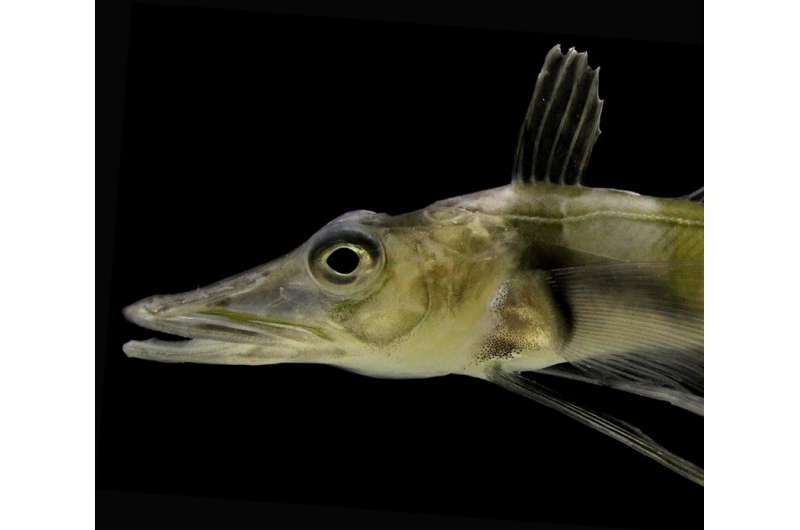An international team of scientists have completed the genome of the Antarctic blackfin icefish, a member of a family of fish that have adapted genetically over 77 million years to survive in the frigid Southern Ocean. Credit: John Postlethwait, University of Oregon
An international team has unveiled the genome of the Antarctic blackfin icefish, opening a genetic window on fish that evolved over the last 77 million years to survive in temperatures below the freezing point of freshwater.
The research team of 22 scientists, including eight University of Oregon co-authors led by biologist John Postlethwait, published its report Feb. 25 online ahead of print in the journal Nature Ecology & Evolution.
From an adult female, researchers mapped 30,773 protein-coding genes and how they localize along chromosomes. The map points to genes that have adapted or disappeared as the fishes acclimated to rising oxygen concentrations as the Southern Ocean cooled to today's average temperature of a frigid 29 degrees Fahrenheit (-1.67 Celsius).
Blackfin icefish (Chaenocephalus aceratus) is in a family of icefish that has long baffled scientists. They lack functional hemoglobin genes, meaning they are white-blooded and lack the red protein that transports oxygen in the blood of every other animal with a backbone. They exist in a constant state of anemia. They have oversized hearts and a low bone mineral density that makes for floppy spines.
In a human, such traits would normally signal disease. These adaptations, however, help the fish survive, said Postlethwait, professor emeritus of biology and member of the UO's Institute of Neuroscience.
The icefishes, he said, are examples of what Charles Darwin called the "wrecks of ancient life." They diverged from the ancestors of stickleback, losing many of the features common to their ancestral forms as they evolved. Among genes that disappeared amid the months of night and months of sunlight in the polar region were those tied to circadian rhythms. The ways they cope, Postlethwait said, could provide insights into health problems of night-shift workers.
The many adaptations, which also include the ability to manufacture antifreeze proteins, make icefish worthy of extensive study and making comparisons to human health, Postlethwait said.
"We will now be able to mine this genome to learn how the fish evolved these seemingly pathogenic traits to their benefit," Postlethwait said. "Understanding how these traits arose over evolutionary time in icefish may help us to appreciate how similar traits—bone loss, decrease in the ability to make blood cells, problems of the circulatory system, obesity—arise in aging humans over developmental time."
Image focuses on the head of a juvenile Antarctic blackfin icefish caught by University of Oregon researchers along along the Antarctic Peninsula. An international team has completed the genome of the white-blooded fish whose adapted traits would normally signal disease in humans. Credit: Thomas Desvignes
Postlethwait raised the idea of studying such adaptations in a species to gain insights into human disease mechanisms and potential new therapies in an article—Wrecks of Ancient Life": Genetic Variants Vetted by Natural Selection -he wrote for the July 2015 issue of the journal Genetics, soon after he was chosen to receive the George W. Beadle Award from the Genetics Society of America.
In the genome project, researchers collected blackfin icefish, which average about 12 inches in length, from various depths near King Sejong Station and the Western Bransfield Strait along the Antarctic Peninsula. Along with genomic DNA taken from the female, RNA was extracted from 12 tissues—brain, eye, gill, heart, intestine, kidney, liver, muscle, ovary, skin, spleen and stomach—to help understand what genes each organ uses.
Much of the DNA sequencing was completed by co-author Hyun Park's group at the Korea Polar Research Institute in Incheon, Korea, and by Wes Warren of Washington University in St. Louis. RNA sequencing and the genetic map of the fish were done in UO research labs and the UO's Genomics and Cell Characterization Core Facility.
The genome assembly and linkage map, the researchers wrote, reveal remarkable stability of contents of the 24 chromosomes among bony fish, including medaka (Japanese rice fish), European sea bass and blackfin icefish spanning 110 million years, especially when compared with chromosome changes in mammals over the same time period. The biggest divergence involved the genes of icefish and sea bass, suggesting changes in the cold.
Icefish and other notothenioid fishes experienced gene changes that produced antifreeze proteins to help them survive—an adaptation discovered in the 1970s by Arthur DeVries of the University of Illinois at Urbana-Champaign. The completed mapping helps place this discovery into a genomic context, the researchers noted.
"Icefish evolved from fish that lived on the bottom and had no swim bladder, an organ that develops like our lungs but then loses the attachment to the pharynx and fills with gas," Postlethwait said. "Most fish, except for bottom feeders, have one and it helps them maintain position in the water column."
When most fish species became extinct around Antarctica as the waters cooled, he said, icefishes evolved to occupy the Southern Ocean water column. One of the biggest challenges they faced, he added, was getting off the bottom without a swim bladder.
"They likely limited the mineralization of their bones, the most dense part of our bodies, and accumulated lipids, which are lighter than water—think of olive oil that floats on the top of the water in a pan about to cook spaghetti," Postlethwait said.
More information: Antarctic blackfin icefish genome reveals adaptations to extreme environments, Nature Ecology & Evolution (2019). DOI: 10.1038/s41559-019-0812-7 , www.nature.com/articles/s41559-019-0812-7
Journal information: Nature Ecology & Evolution , Genetics
Provided by University of Oregon

























